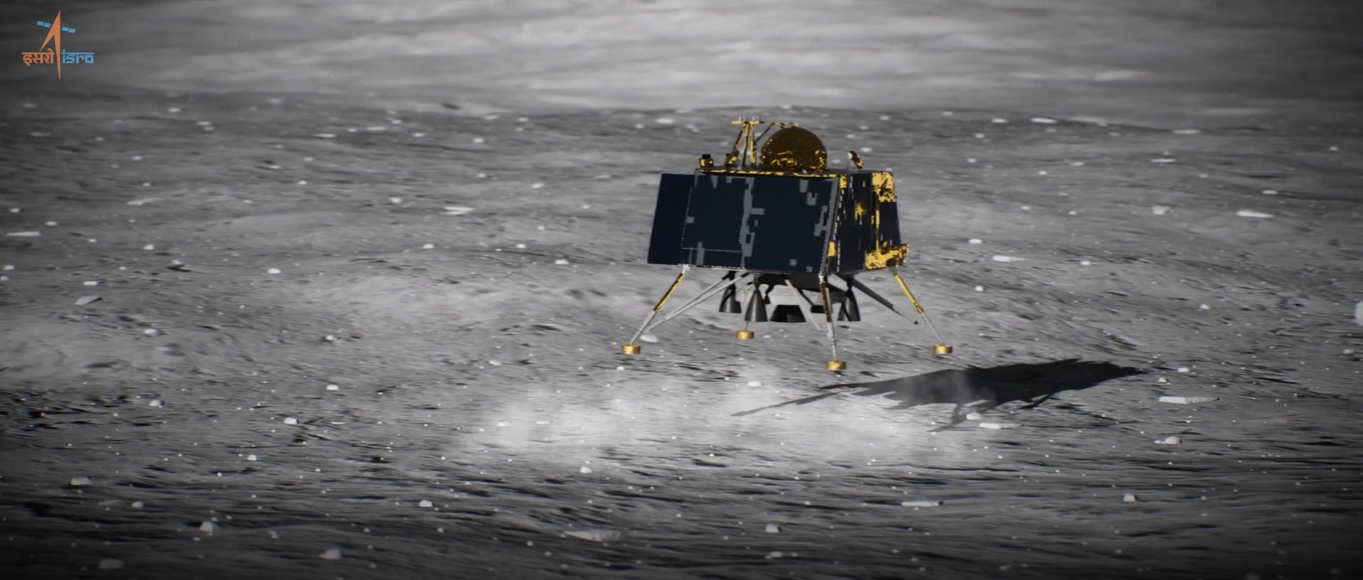India's Silent Moon Lander Could Be in One Piece After 'Hard Landing': Reports

India's quest to restore contact with its Chandrayaan-2 moon lander is continuing this week, with new images suggesting the Vikram probe may still be in one piece on the lunar surface, according to Indian media reports.
The reported images, which have not been released by India's space agency, come days after the Vikram lander fell silent during a daring moon landing attempt near the lunar south pole.
Mission personnel at the India Space Research Organisation (ISRO) are in a race against time: Even before the hard landing, the odds of the lander surviving the frigid lunar night, which will begin just two weeks after its touchdown, were low. But ISRO director K. Sivan confirmed that his team would use that full window to attempt to establish communications with the lander, and reporting by The Times of India suggests that the team has made progress in evaluating the Vikram lander's current status.
"It had a hard-landing very close to the planned (touch-down) site as per the images sent by the on-board camera of the orbiter," The Times of India quoted an unnamed ISRO official as saying. "The lander is there as a single piece, not broken into pieces. It's in a tilted position."
ISRO has not publicly confirmed the condition of the Vikram moon lander.
Related: India's Chandrayaan-2 Mission to the Moon in Photos
Another ISRO official told The Times of India that the team has experience re-establishing communications with satellites that have struggled in Earth's orbit, but that doing so on the surface of the moon is much more challenging.
The agency's odds of success depend on whether the Vikram lander's antennas are pointing either toward the Chandrayaan-2 orbiter still circling the moon or toward Earth itself, the same official told The Times of India. The lander has solar panels at a variety of angles and carries internal batteries as well, upping its odds of survival at a strange angle on the surface.
But the rough landing may well have damaged internal mechanisms even while leaving Vikram in one piece, another ISRO official told The Times of India. "Only if it had a soft-landing and if all systems functioned, then only communications can be restored," that official said. "Things are bleak as of now."
Get the Space.com Newsletter
Breaking space news, the latest updates on rocket launches, skywatching events and more!
ISRO's look at the lander so far has come from the Chandrayaan-2 orbiter. The duo launched on July 22 and separated on Sept. 2 in preparation for the moon-landing attempt. Chandrayaan-2 is designed to last a year circling the moon from pole to pole and while carrying a suite of eight instruments. One of those instruments, according to ISRO, is the highest-resolution camera to be placed in lunar orbit to date, capable of resolving features just 1 foot (0.3 meters) across.
The orbiter follows India's successful Chandrayaan-1 orbiter, which carried the device that confirmed slabs of water ice are hidden below the lunar surface inside craters at the south pole. The Chandrayaan-2 mission was designed to build on this success by augmenting a second orbiter with a lander and rover that would target the southernmost landing site to date.
But late in the landing maneuver on Sept. 6, about 1.2 miles (2 kilometers) above the moon's surface, something appears to have gone wrong. The Vikram lander's course began to stray from its targeted landing site, then signals from the spacecraft stopped. Mission control, in the early hours of the morning local time, also fell silent in vain anticipation.
Despite the continuing uncertainties about what happened during the landing maneuver and the current state of Vikram, ISRO has said that even without the lander and rover, the Chandrayaan-2 mission as a whole has met between 90% and 95% of its objectives.
- India Looks Beyond the Moon to Mars, Venus and Astronaut Missions
- Here's What India's Prime Minister Modi Told Chandrayaan-2 Scientists After Moon Landing Went Awry
- India Looks to Build on Lunar Legacy with Historic Moon Landing
Email Meghan Bartels at mbartels@space.com or follow her @meghanbartels. Follow us on Twitter @Spacedotcom and on Facebook.
Join our Space Forums to keep talking space on the latest missions, night sky and more! And if you have a news tip, correction or comment, let us know at: community@space.com.

Meghan is a senior writer at Space.com and has more than five years' experience as a science journalist based in New York City. She joined Space.com in July 2018, with previous writing published in outlets including Newsweek and Audubon. Meghan earned an MA in science journalism from New York University and a BA in classics from Georgetown University, and in her free time she enjoys reading and visiting museums. Follow her on Twitter at @meghanbartels.









